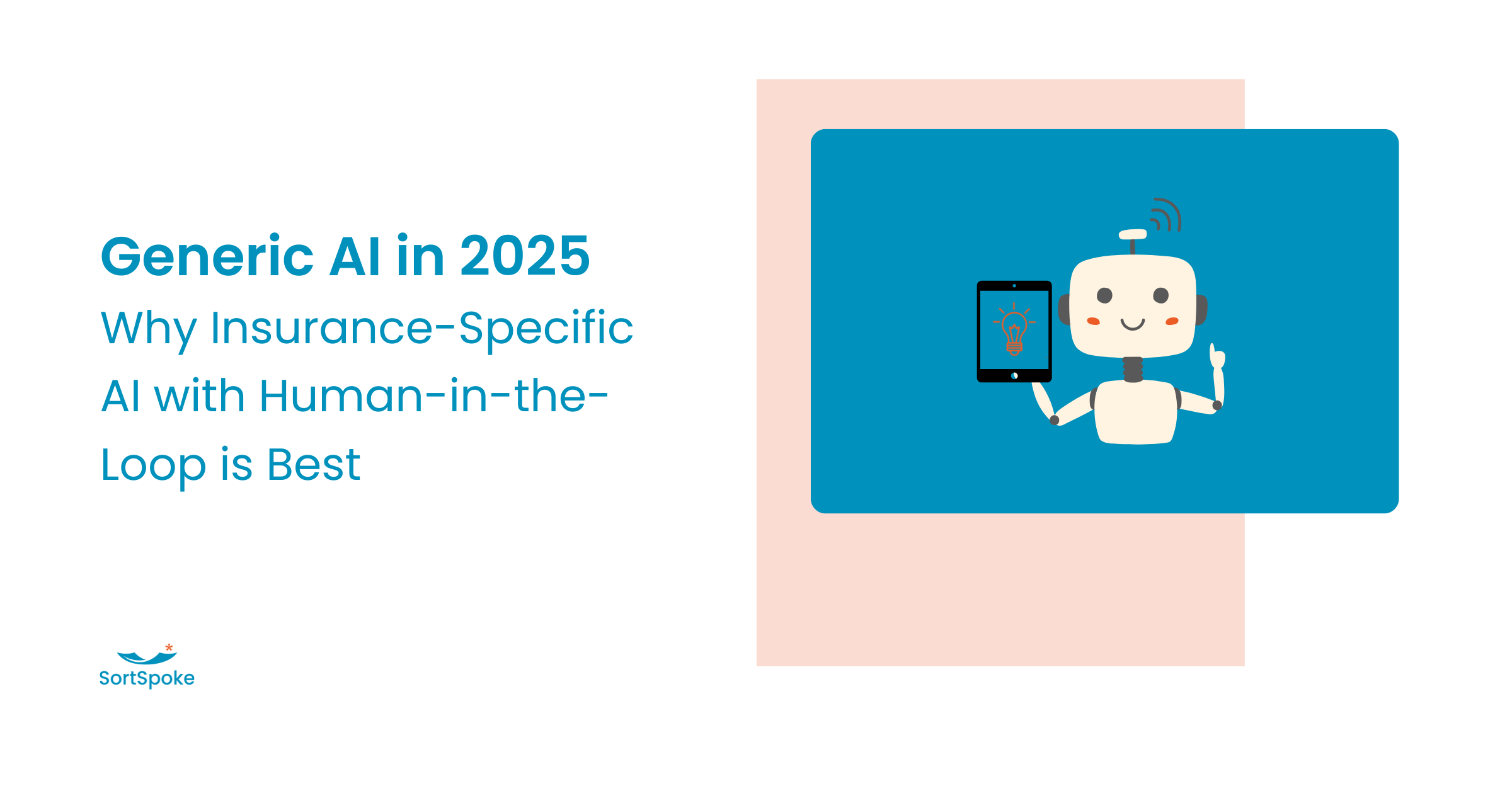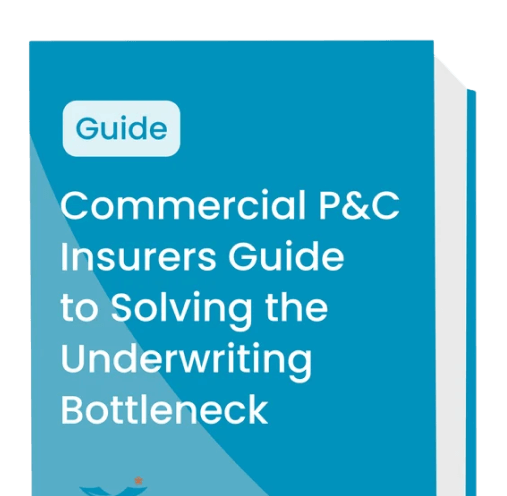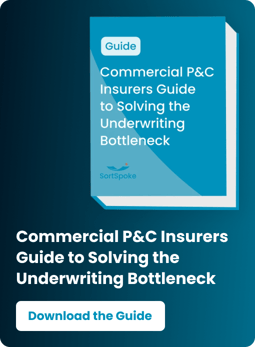
Insurance-Specific AI with Human-in-the-Loop Outperforms Generic AI
TL;DR
- Generic AI models lack insurance-specific understanding, while purpose-built solutions like SortSpoke are trained on insurance documents and workflows
- Human-in-the-loop validation ensures 100% accuracy while allowing underwriters to process submissions 5X faster
- Compliance is fundamental to system design in insurance-specific AI, not an afterthought
- Integrated workflows with underwriter control preserve the crucial judgment and expertise that algorithms can't replace
- Insurance-specific AI significantly reduces technical overhead and provides faster time-to-value compared to general-purpose AI
The AI Revolution in Insurance Is Already Here—But It's Not What You Think
When you hear "AI in insurance," your mind might instantly jump to chatbots answering customer questions or algorithms automatically approving basic policies. But the real revolution is happening behind the scenes—in the complex, document-heavy workflows that form the backbone of insurance operations.
In 2025, insurance companies face a critical decision: invest in generic, one-size-fits-all AI solutions that promise the world but may deliver disappointment, or implement insurance-specific AI designed explicitly for the unique challenges of underwriting and submission processing.
For underwriters drowning in submission documents and struggling to efficiently extract critical information, this choice is particularly consequential. Let's examine why domain-specific AI solutions with human-in-the-loop validation deliver superior results compared to general purpose AI models.
Built on Insurance Expertise, Not Just Data Science
General AI models like ChatGPT, Gemini, and Claude are undeniably impressive technological achievements. They've been trained on vast amounts of public information and can generate seemingly coherent text on almost any topic. However, these models fundamentally lack the specialized understanding that insurance operations require.
Insurance-specific AI solutions like SortSpoke are built differently. They're developed on carefully curated collections of insurance documents and workflows, capturing the industry's unique terminology, document structures, and information hierarchies. This specialized training enables them to understand the context and relevance of information in ways generic models simply cannot.
Unlike general AI models that process text as statistical patterns, insurance-specific AI understands the difference between a submission form, a loss run report, and a policy endorsement, and knows exactly what information underwriters need from each.
According to industry experts, AI systems with insurance-specific training can reduce the average underwriting decision time from 3-5 days to just minutes for standard policies, while maintaining over 99% accuracy in risk assessment."
The Human-in-the-Loop Difference: Control + Efficiency
The most effective AI solutions in insurance don't attempt to replace human expertise—they amplify it. This is the core philosophy behind SortSpoke's human-in-the-loop approach.
In a human-in-the-loop system, AI handles the initial heavy lifting of processing complex insurance documents, extracting key data points, and organizing information. Then, underwriters validate the extracted data, make necessary corrections, and apply their expertise to the decision-making process.
This collaborative model delivers several crucial benefits:
1. Maintaining 100% Accuracy While Processing 5X Faster
In insurance underwriting, accuracy isn't just nice to have—it's essential. A single error in extracted data can lead to significant mispricing or inappropriate risk acceptance.
Human-in-the-loop validation ensures that every piece of extracted data is verified by an expert, maintaining 100% accuracy while still achieving dramatic efficiency improvements. Underwriters can process submissions up to five times faster while maintaining complete confidence in their data.
2. Continuous Learning Without Technical Expertise
Each time an underwriter validates or corrects AI-extracted data, the system learns and improves. This creates an on-going cycle where the AI becomes increasingly accurate over time, without requiring specialized technical skills from the underwriters themselves.
Unlike generic AI models that require data scientists to retrain and fine-tune, insurance-specific AI with human-in-the-loop design improves naturally through everyday use.
3. Full Transparency and Auditability
Insurance decisions must be explainable and auditable. The black-box nature of many general AI solutions creates significant compliance and transparency issues.
Human-in-the-loop systems provide complete visibility into where each data point came from, with clear sourcing to document, page, and section. This traceability is essential for regulatory compliance, audit trails, and defending underwriting decisions.
VP of Commercial Underwriting"SortSpoke's human-in-the-loop approach gave us the perfect balance: the efficiency of AI with the judgment and oversight of our experienced underwriters. We've dramatically increased capacity without sacrificing quality."
National Property & Casualty Insurer
Regulatory Compliance by Design
Insurance operates under strict regulatory frameworks that vary by state, line of business, and jurisdiction. For insurance operations, compliance isn't an afterthought—it's fundamental to system design.
Insurance-specific AI incorporates compliance at its core, with built-in safeguards for:
- Protected health information (HIPAA)
- Personal data (GDPR/CCPA)
- Fair lending requirements
- State-specific regulations
- Document retention requirements
- Audit trails
Generic AI models typically lack these specific compliance controls, creating potential regulatory exposure when implemented in insurance environments.
The Technical Advantage: Reduced Overhead and Faster Deployment
Implementing general-purpose AI in insurance operations typically requires significant support infrastructure and technical expertise:
- Large data science teams
- Extensive data preparation and engineering
- AI specialists for monitoring and maintenance
- Continuous prompt engineering and testing
- Additional hardware infrastructure
Domain-specific insurance AI solutions dramatically reduce this burden. Systems like SortSpoke are designed specifically for insurance workflows, with pre-built capabilities for common document types and integration with existing underwriting systems.
This specialized design enables much faster deployment—often in weeks rather than months—and significantly lower technical overhead. The result is faster time-to-value and higher ROI.
What is Human-in-the-Loop AI?
Human-in-the-Loop (HITL) AI is an approach that combines machine intelligence with human expertise, creating a collaborative system where AI handles initial data processing while humans provide oversight, validation, and judgment.
In insurance document processing, HITL enables AI to extract information from complex materials while allowing underwriters to verify accuracy, interpret context, and make nuanced decisions that require domain knowledge—creating a system that's more accurate and trustworthy than either humans or AI working alone.
Real-World Impact: Transforming Underwriting Efficiency
When we talk about AI in insurance, the proof is in the results. What actual impact can the right AI solution have on underwriting operations?
Insurance companies implementing domain-specific AI with human-in-the-loop validation are seeing remarkable improvements:
- 50% increase in submission-to-quote ratio within just 30 days
- 5X faster submission processing while maintaining 100% accuracy
- Dramatic reduction in manual data entry, freeing underwriters to focus on analysis and decision-making
- Higher bind rates through faster quote turnaround
- Improved underwriter satisfaction by eliminating tedious document processing tasks
The Future of Insurance Document Processing







